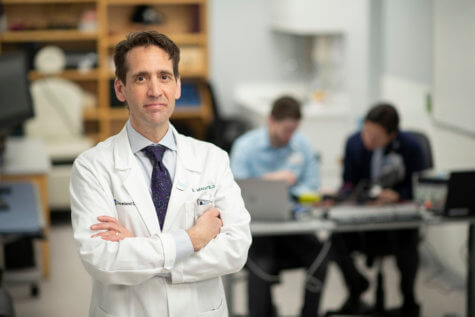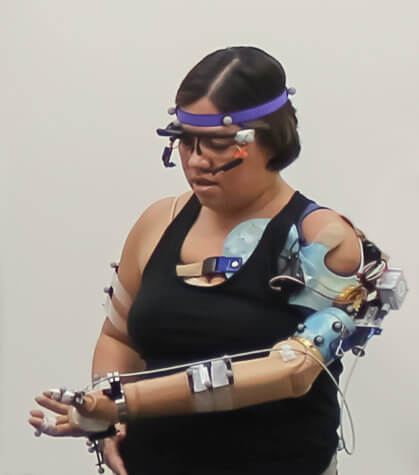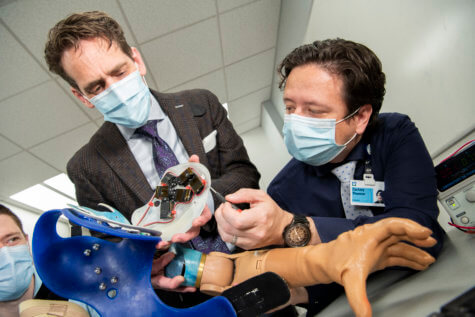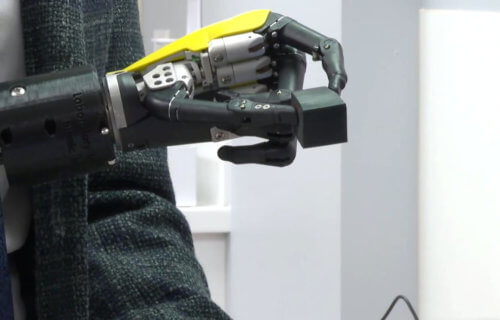CLEVELAND — An incredible, sci-fi-like bionic arm can actually enable amputees to recover their sense of touch again. The groundbreaking technology combines intuitive motor control, touch and grip — producing the sensation of actually opening and closing a hand.
Researchers say the brain-computer interface is the first to test all three functions all at once in a prosthetic device.
“They feel as if one of their hands are moving – even though they don’t have a hand,” says lead investigator, Professor Paul Marasco, of the Cleveland Clinic, in an interview per South West News Service. “They feel as if their fingers are touching things – even though they don’t have fingers. The interesting thing about it is when we put all of these systems together their brains actually feel like the hand is human.”
The bionic arm links to limb nerves which send impulses from the patient’s brains to the prosthetic when they want to use or move it. The robotic arm also receives physical information from the environment, relaying it back to their brain through their nerves.

“We modified a standard-of-care prosthetic with this complex bionic system which enables wearers to move their prosthetic arm more intuitively and feel sensations of touch and movement at the same time,” explains Marasco, who leads the Laboratory for Bionic Integration, in a statement. “These findings are an important step towards providing people with amputation with complete restoration of natural arm function.”
The bi-directional feedback and control allowed participants to perform tasks with a similar degree of accuracy as non-disabled peers.
“Perhaps what we were most excited to learn was that they made judgments, decisions and calculated and corrected for their mistakes like a person without an amputation,” says Marasco. “With the new bionic limb, people behaved like they had a natural hand. Normally, these brain behaviors are very different between people with and without upper limb prosthetics.”
Bionic arm makes ‘huge difference’ in lives of amputees in study
The bionic arm was tested on two study individuals with arm amputations who had previously undergone targeted sensory and motor re-innervation The procedures establish a neural-machine interface by redirecting amputated nerves to remaining skin and muscles. Touching the skin with small robots activated sensory receptors that helped them perceive the sensation of touch.
When the patients thought about moving their limbs, the re-innervated muscles communicated with a computerized prosthesis to move in the same way. The powerful machines also vibrated kinesthetic sensory receptors in those same muscles – leading them to ‘feel’ their hand and arm were moving.
Both participants were able to carry out basic, everyday tasks requiring hands and arms wearing the prosthetic. They ranged from picking up and using cups, bottles and pegs to grasping a pen to write with. One of the volunteers even used a smartphone.

Advanced evaluation tools show the volunteers’ performances were better than people with amputations using traditional prosthetic devices. They were even comparable to those of non-disabled people, said the international team.
One of the patients with the new bionic arm, 41-year-old Claudia Mitchell of Arkansas, said it’s made a “huge difference” in her life. “When I lean it back it’s touching my ‘finger’,” she explains. “I can actually tell which one. I can feel that.”
Everyday activities like opening and grabbing a water bottle and cutting a peach to make a pie are now much easier for Mitchell. The U.S. Marine veteran lost her left arm at the shoulder in a 2004 motorcycle accident.
She can also adeptly pick up a make-up bag using her prosthetic thumb and forefinger – and feel an object and know how hard to grip it. “They were activities I once thought would never again be possible,” she says.
Driven by medical technology that sounds like it could be from a science-fiction movie, her customized prosthetic is outfitted with a powerful computerized robotic touch system. It allows her to feel sensation and movement as if it was coming from her missing hand. Her brain interprets the arm like it’s her own. More than a prosthetic, she says it’s actually part of her. She can interact with other people in a natural way.
Struggles from standard prosthetics are reduced with new technology
The other participant in the study was wildfire ranger Rob Anderson, 43, from Grande Prairie, Alberta, Canada. He and Mitchell were also assessed when the three sensory and motor modalities were enabled together versus individually.
As people with traditional prosthetics cannot feel with their limbs, they behave differently than those without an amputation while completing daily chores. For example, they must constantly watch their device while using it, explains Marasco. They also have trouble learning to correct for mistakes when they apply too much or little force with their hand.
With the new artificial arm the researchers could see the pairs’ brain and behavioral strategies changed to match those of a person without an amputation. They no longer needed to watch their prosthesis, and they could find things without looking. They could also more effectively correct for mistakes.

“Over the last decade or two, advancements in prosthetics have helped wearers to achieve better functionality and manage daily living on their own,” says Marasco. “For the first time, people with upper limb amputations are now able to again ‘think’ like an able-bodied person, which stands to offer prosthesis wearers new levels of seamless reintegration back into daily life.”
The analysis, published in Science Robotics, can be applied to any upper limb prosthetic or deficit that involves sensation and movement.
“We built the system actually using an off the shelf prosthetic as our basis. Then we put in high level computing, touch and movement sensation. When you look at the limb it actually looks like any other,” says Marasco. “You can’t tell there’s actually a highly sophisticated, computerized communication and feedback system running inside of that.”
South West News Service writer Mark Waghorn contributed to this report.
